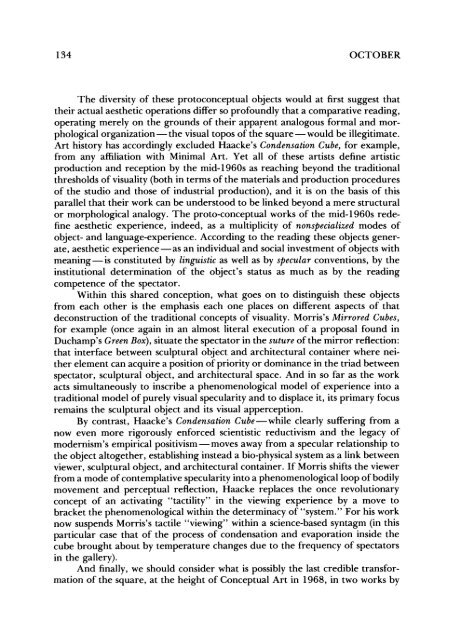Buchloh, conceptual art.pdf - Course Materials Repository
Buchloh, conceptual art.pdf - Course Materials Repository
Buchloh, conceptual art.pdf - Course Materials Repository
Create successful ePaper yourself
Turn your PDF publications into a flip-book with our unique Google optimized e-Paper software.
134 OCTOBER<br />
The diversity of these proto<strong>conceptual</strong> objects would at first suggest that<br />
their actual aesthetic operations differ so profoundly that a comparative reading,<br />
operating merely on the grounds of their apparent analogous formal and morphological<br />
organization - the visual topos of the square - would be illegitimate.<br />
Art history has accordingly excluded Haacke's Condensation Cube, for example,<br />
from any affiliation with Minimal Art. Yet all of these <strong>art</strong>ists define <strong>art</strong>istic<br />
production and reception by the mid-1960s as reaching beyond the traditional<br />
thresholds of visuality (both in terms of the materials and production procedures<br />
of the studio and those of industrial production), and it is on the basis of this<br />
parallel that their work can be understood to be linked beyond a mere structural<br />
or morphological analogy. The proto-<strong>conceptual</strong> works of the mid-1960s redefine<br />
aesthetic experience, indeed, as a multiplicity of nonspecialized modes of<br />
object- and language-experience. According to the reading these objects generate,<br />
aesthetic experience -as an individual and social investment of objects with<br />
meaning-is constituted by linguistic as well as by specular conventions, by the<br />
institutional determination of the object's status as much as by the reading<br />
competence of the spectator.<br />
Within this shared conception, what goes on to distinguish these objects<br />
from each other is the emphasis each one places on different aspects of that<br />
deconstruction of the traditional concepts of visuality. Morris's Mirrored Cubes,<br />
for example (once again in an almost literal execution of a proposal found in<br />
Duchamp's Green Box), situate the spectator in the suture of the mirror reflection:<br />
that interface between sculptural object and architectural container where neither<br />
element can acquire a position of priority or dominance in the triad between<br />
spectator, sculptural object, and architectural space. And in so far as the work<br />
acts simultaneously to inscribe a phenomenological model of experience into a<br />
traditional model of purely visual specularity and to displace it, its primary focus<br />
remains the sculptural object and its visual apperception.<br />
By contrast, Haacke's Condensation Cube-while clearly suffering from a<br />
now even more rigorously enforced scientistic reductivism and the legacy of<br />
modernism's -<br />
empirical positivism moves away from a specular relationship to<br />
the object altogether, establishing instead a bio-physical system as a link between<br />
viewer, sculptural object, and architectural container. If Morris shifts the viewer<br />
from a mode of contemplative specularity into a phenomenological loop of bodily<br />
movement and perceptual reflection, Haacke replaces the once revolutionary<br />
concept of an activating "tactility" in the viewing experience by a move to<br />
bracket the phenomenological within the determinacy of "system." For his work<br />
now suspends Morris's tactile "viewing" within a science-based syntagm (in this<br />
p<strong>art</strong>icular case that of the process of condensation and evaporation inside the<br />
cube brought about by temperature changes due to the frequency of spectators<br />
in the gallery).<br />
And finally, we should consider what is possibly the last credible transformation<br />
of the square, at the height of Conceptual Art in 1968, in two works by
















